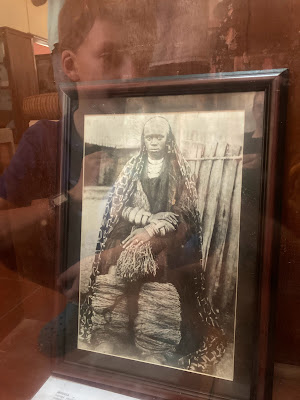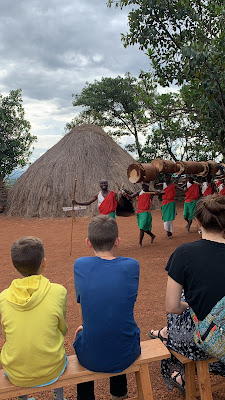By Julie Banks
We recently took a couple visitors to the Burundi National Museum in Gitega. We had been there once before, and were fascinated by the collection of artifacts and photos from Burundi when it was a kingdom.
Both times we have visited this museum, we’ve been given a personal tour by friendly and knowledgeable museum employees. As this most recent host was showing us one of the first photographs of the Royal Drummers of Burundi, he pointed out his ancestor in the photo. (It was difficult to translate exactly how many “great-greats” there were.) Then he shared that he, too, was a Royal Drummer many years ago.
 |
| A Burundian warrior - each piece baring significance |
He told us about the Drum Sanctuary of Gishora nearby. We had heard of this Drum Sanctuary, but had ever been. While it is one of the most notable sites in Burundi, we just somehow never made it happen to go. I think we all can identify with this – you never do the touristy things in your own city or state unless you have a visitor, or are on a field trip for school!
But somehow today seemed like the day to do it.
A few of our other teammates were already on their way to Gitega, where we were, so we sent them a quick text: : “Hey we met a guy who said he could arrange for us to go see the Drum Sanctuary. Do you want to come?”
And that was pretty much all the information we had! We hung out at a local shop on the town square, and waited for our friends to arrive. The shop owner’s wife gave us some treats she had made while we waited. Our teammates arrived and now we had 2 cars full of Americans eager to see this famous site.
 |
| Smelling the Royal incense |
We swung back by the Museum to pick up our new guide. He found a seat in our van and off we went. He was sitting in the very back of the van and I was up front in the passenger’s seat. So translating was a bit inconvenient, but at least the whole van was able to hear what he was sharing.
He began naming off American states and cities, and we quickly remarked that his US geography knowledge seemed way above average. Then he told us he has been to the United States. Now this one I had to confirm a couple times to make sure I understood his French, because it is quite rare to find Burundians who have traveled to the United States. He told us he was in fact on a world tour with the Royal Burundian Drummers. Again, I’m surprised. I’m finding out that when he said he had been a Burundian drummer, he was serious! (His stories were fascinating, but too much for this one blog post!)
We learned, first hand, what we had read or heard about becoming a Royal Drummer. It’s akin to nobility. One’s bloodline chooses for them if they will be one of the drummers. As I understand it, true Burundian drummers will be from the Gishora region, and it is passed down from father to son. Some of us have seen Burundian drummers perform at various events such as HAU graduation, but this was different. We were about to see the birthplace of the famous drummers.
Historically the drummers were not just performers. They were like the King’s noblemen and the knights. They were also warriors. In fact, one of his grandfathers, (again I don’t know how many “greats”) helped hide the King of Burundi from the Germans who were searching for the King in the late 1800s. They hid him in a granary and he was not found! He was very proud of his heritage.
 |
| Zeke looking at the King's wife adorned from head to toe. |
So after a car ride full of interesting stories, we arrived at the Sanctuary. The Burundian drum is very sacred in this country. The drums represent fertility and regeneration, two important concepts in a largely agricultural society. The drum itself is made from a hallowed out tree trunk of a tree that can only be found in Burundi, and the drum head is made from cows who are bred specifically to become a drum.
The first thing we were shown was the oldest drum in Burundi. It is housed in its own hut, and the drum is the only thing that is in this hut. The door of the hut is low on purpose so that it forces anyone who would enter to bow down and show respect.
 |
| Modeling how one must respectfully enter the King's presence |
 |
| Intern Joshua sitting on the King's stool with his spear and guillotine. |
The tour ended with a performance from the drummers. This was last minute, so I think they gathered whomever they could from the team and gave us the best show they could! The drummers enter with the drums on their head. They are led by one who carries a shield and a spear and leads the singing.
They land in a crescent shape with one large drum placed in the middle. There are three simultaneous rhythms being made with different size drums that produce the famous sound of these drums. As they drum, they take turns taking the middle of the crescent to perform physical feats like jumping and dancing. All the while smiling.
The drummers also tell stories with their singing and dancing about war, animals, crops, and their leader. The rhythm is powerful and these men will make you love Burundi by the time they finish! Before they finished however, they invited a few of us to join their dancing. We had such a great time.
One of the local ladies heard that there were some doctors from Kibuye in the village so she gathered all her medical records and brought them to our team. So, after the performance a few of the doctors gave an impromptu consultation!
 |
| Logan and 2 visiting physicians seeing how they could help this Gishora woman |
It was an adventurous day and it made us appreciate, respect, and love Burundi even more.











No comments:
Post a Comment